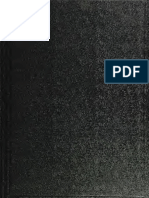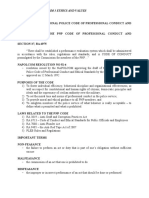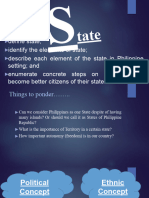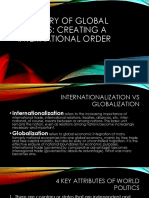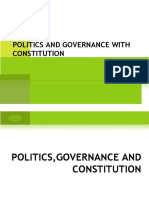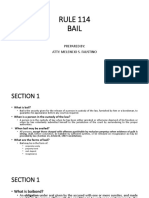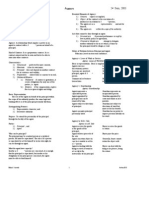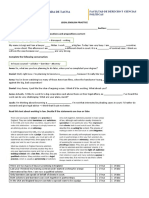0 ratings0% found this document useful (0 votes)
108 viewsPolitical Science
Political Science
Uploaded by
Melencio Silverio FaustinoPolitical science is the study of state and government through systematic reflection on politics. It examines how people and institutions exercise and resist power, usually focusing on processes within sovereign states. The key elements of a state include people, territory, government, and sovereignty. A state's government acts as the instrument through which the state's will is implemented and exercises powers over both domestic and foreign affairs.
Copyright:
© All Rights Reserved
Available Formats
Download as PPTX, PDF, TXT or read online from Scribd
Political Science
Political Science
Uploaded by
Melencio Silverio Faustino0 ratings0% found this document useful (0 votes)
108 views53 pagesPolitical science is the study of state and government through systematic reflection on politics. It examines how people and institutions exercise and resist power, usually focusing on processes within sovereign states. The key elements of a state include people, territory, government, and sovereignty. A state's government acts as the instrument through which the state's will is implemented and exercises powers over both domestic and foreign affairs.
Original Description:
Polsci ppt
Copyright
© © All Rights Reserved
Available Formats
PPTX, PDF, TXT or read online from Scribd
Share this document
Did you find this document useful?
Is this content inappropriate?
Political science is the study of state and government through systematic reflection on politics. It examines how people and institutions exercise and resist power, usually focusing on processes within sovereign states. The key elements of a state include people, territory, government, and sovereignty. A state's government acts as the instrument through which the state's will is implemented and exercises powers over both domestic and foreign affairs.
Copyright:
© All Rights Reserved
Available Formats
Download as PPTX, PDF, TXT or read online from Scribd
Download as pptx, pdf, or txt
0 ratings0% found this document useful (0 votes)
108 views53 pagesPolitical Science
Political Science
Uploaded by
Melencio Silverio FaustinoPolitical science is the study of state and government through systematic reflection on politics. It examines how people and institutions exercise and resist power, usually focusing on processes within sovereign states. The key elements of a state include people, territory, government, and sovereignty. A state's government acts as the instrument through which the state's will is implemented and exercises powers over both domestic and foreign affairs.
Copyright:
© All Rights Reserved
Available Formats
Download as PPTX, PDF, TXT or read online from Scribd
Download as pptx, pdf, or txt
You are on page 1of 53
POLITICAL SCIENCE
• Political science is the study of state and
government
• It is the systematic study of and reflection upon
politics
• Politics usually describes the processes by which
people and institutions exercise and resist power
• Political comes from the Greek word “polis”
which means “city” or what today refer to
sovereign state
• Science from Latin word “scire” which means “to
know”
People as the focal of all areas of
Politics, Government and Constitution.
INTERPRETATION OF THE DIAGRAM
• People as the focal of all areas of politics,
government and Constitution.
• It is the human individual who is the revolving
actor of the state; it is to the people why there
is an existence of law
• The right is vested to and it simple denotes
that people is the main actor and the recipient
of the basic reason why law exists
SCIENCE OF POLITICS
• It is the basic knowledge and understanding of
the state and the principles and ideals which
underlies its organization and activities
• It is primary concerned with the association of
human beings into body politic or political
community
• It deals with relations among men and groups
which are subject to control by the state with
relations of men and groups to the state itself
and the relation of the state to the other state
SCOPE OF POLITICAL SCIENCE
• Political Law: body of doctrines relating to the
origin, form, behavior and purposes of the
State
• Public Law: the organization of the
government, its powers and duties and
limitations of the government
• Public Administration: methods and
techniques used in the actual management of
business affairs
IMPORTANCE OF POLITICAL SCIENCE
• To discover the principles that should be
adhered in public affairs and to study the
operations of the government
• Its findings can be used in seeking immediate
solutions to a given and immediate situations
• To be able to deal with social and economic
problems and other matters of public and
private concerns
CONCEPT OF STATE
State is a community of persons, more or less numerous,
permanently occupying a definite portion of territory,
independent of external control, and possessing a
government to which a great body of inhabitants render
obedience
Distinguished from Nation. State is a legal or juristic
concept, while nation is ethnic or racial concept
Distinguished from Government. Government is merely
an instrumentality of the State through which the will of
the State is implemented and realized
STATE VS. NATION
• State is legal/political concept; Nation is an ethnic concept
• One State may consist of one or more nations; one Nation
maybe made of several states
• State is the principal; Nation is the agent
• State is an abstraction; Nation externalize the will of the
State
• State cannot exists without the government; can exists
without the government
• State cannot be changed as long as the elements are
present; Nation can be changed
• State, the people are heterogeneous; Nation the people are
homogeneous
THEORIES OF STATE ORIGIN
• Divine Theory: The state is of Divine origin. All
political authority emanates from God
• Social Contract Theory: This theory states that all
men agreed among themselves under one civil
society or body politic. A person surrendered
natural liberty but gained in return the protection
and civil rights guaranteed by the government
• Force Theory: The state has arisen thru sheer
force. A tribe conquering other tribes to form a
kingdom
ELEMENTS OF STATE
1. People
2. Territory
3. Government
4. Sovereignty
PEOPLE
• Simply refers to the inhabitants of the State
• Different meanings as used in the
Constitution: (i) inhabitants [Sec. 2, Art. III;
Sec. 1, Art. XIII]; (ii) Citizens [Preamble; Secs. 1
& 4, Art. II; Sec. 7, Art. III]; (iii) Electors [Sec. 4,
Art. VII]
• As a requisite for statehood: Adequate enough
for self-sufficiency
TERRITORY
• Fixed portion of the surface of the earth
inhabited by the people of the State
• Components: (1) Terrestial domain or the land
mass; (2) Maritime and Fluvial domain or
inland and external waters; (3) Aerial domain
or the air space above the land and waters
TERRITORY
• The Philippine territory (Art I, 1987 Constitution)
The national territory comprises the Philippine
archipelago, with all the islands and waters embraced
therein, and all other territories over which Philippines
has sovereignty or jurisdiction, consisting of its
terrestrial, fluvial, and aerial domains, including its
territorial sea, the seabed, the subsoil, the insular
shelves, and other submarine areas. The waters around,
between and connecting the islands of the archipelago,
regardless of their breadth and dimension, form part of
the internal waters of the Philippines.
TERRITORY
• Archipelago Doctrine: “The waters around,
between and connecting the islands of the
archipelago, regardless of their breath and
dimension, form part of the internal waters of the
Philippines [2nd sentence, Sec. 1, Art. 1]
• This articulates the archipelagic doctrine of
national territory based on the principle that an
archipelago, which consists of a numerous island
separated by numerous bodies of water should
be treated as one integral unit
TERRITORY
• Straight baseline method: Imaginary straight lines
are joining the outmost points of outermost
islands of the archipelago, enclosing an area the
ratio of which should not be more than 9:1
(water to land); provided that the drawing of
baselines shall not depart, to any appreciable
extent, from the general configuration of
archipelago. The water within the baseline shall
be considered internal waters; while the breadth
of the territorial sea shall then be measured from
the baselines
TERRITORY
• UN Convention on the law of the Sea [April 30,
1982; ratified by the Philippines in August,
1983] provides:
– Territorial sea – 12 miles
– Contiguous zone – 24 miles
– Exclusive Economic Zone – 200 miles
Note: Measures from the baseline (usually mean
low-water mark) of a coastal state.
TERRITORY
• The Philippine Archipelago covers the
following territories: (i) Treaty of Paris [Dec.
10, 1898] which is the cession of the Phil
Islands by Spain to the United States; (2)
Treaty between Spain and US at Washington
[Nov 7, 1900] covering Cagayan, Sulu and
Sibuto); (iii) Treaty between Us and Great
Britain [Jan 2, 1930] over Turtle and Mangsee
Islands
GOVERNMENT
• The agency or instrumentality through which the will of the State is
formulated, expressed and realized (US v. Dorr, 2 Phil 332)
• Mandate of government: “To promote the welfare of the people.
• Our constitution requires our government to be democratic and
republican
• Sec.1 Art. II, 1987 Constitution: The Philippines is a Democratic and
Republican State. Sovereignty resides from the people and all
authority emanates from them.
• Republican: One wherein all government authority emanates from
the people and is exercised by representative chosen by the people
• Democratic: This emphasizes that the Philippines has some aspects
of direct democracy
GOVERNMENT
• Functions:
1) Constituents – mandatory for the government to
perform because they constitute the very bond
of the society, such as the maintenance of peace
and order, regulation of property and property
rights, the administration of justice, etc.
2) Ministrant, those intended to promote the
welfare, progress and prosperity of the people
such as public works, public charity, and
regulation of trade and industry and which are
merely optional for the government to perform.
GOVERNMENT
• Doctrine of parens patriae.
– Literally parent of the people. As such the
government may act as guardian of the rights of
people who may be disadvantaged or suffering
from some disability or misfortune
GOVERNMENT
• Classifications:
(1) De jure vs. De facto Governments
(2) Presidential vs Parliamentary Governments
(3) Unitary vs. Federal Government
GOVERNMENT
(1) A de jure government is the legal, legitimate
government of a state and is so recognized by
other states. In contrast, a de facto government
is in actual possession of authority and control
of the state.
For example, a government that has been
overthrown and has moved to another state
will attain de jure status if other nations
refuse to accept the legitimacy of the
revolutionary government.
GOVERNMENT
The presidential model, sometimes called a
“congressional system,” was invented in the U.S.
in 1787.
The parliamentary system, sometimes called a
“cabinet government” may also be
a constitutional monarchy. A constitutional
monarchy retains the king or queen in the role
of head of state, but their power is almost
exclusively ceremonial.
GOVERNMENT
• Federal government is a type of national
government in which government have
powers to delegates the power to other
elected member of the states.
• Unitary government is a kind of government
system in which a single power, which is
known as the central government, controls
the whole government.
GOVERNMENT
• As to number of persons exercising sovereign
powers
1) Monarchy – one in which the supreme
and final authority is in the hands of a single
person.
2) Aristocracy – one in which political
power is exercised by a few privileged class
3) Democracy – one in which political
power is exercised by a majority of people.
SOVEREINTY
• The supreme power of the state to command and
enforce obedience to its will from people and to
have freedom from foreign control
• Kinds:
– Legal: power to issue final command or Political: the
sum total of all influences which lie behind the law
– Internal: the supreme power over everything within
its territory or External: otherwise known as
independence or freedom from external control
SOVEREINTY
• Characteristics: Permanence; exclusiveness,
comprehensiveness, absoluteness,
indivisibility, inalienability, imprescriptibility
(Laurel v. Misa, 77 Phil. 856)
• Effects of Change of sovereignty: Political laws
are abrogated (Pp v. Perfecto, 43 Phil 887);
Municipal laws remain in force (Vilas v. City of
Manila, 228 US 335)
Sovereignty vs. Independence
• Sovereignty is a broader concept. It has two
aspects
– Internal: freedom of the State to manage its own
affairs; implement its own laws throughout the
country
– External: freedom of the State to direct its foreign
affairs
• Independence is synonymous with External
Sovereignty. It is defined as the power of the
State to manage its external affairs without the
inference from another State
DUTIES OF THE STATE
• Peace and order
• Political harmony (good laws)
• Social Justice
• Economic development
INTRODUCTION TO PHILIPPINE
GOVERNMENT
POLITICAL LAW, Definition:
Branch of public law which deals with
organization and operations of the
governmental organs of the State and defines
relation of the State with the inhabitants of its
territory (People vs. Perfecto, 43 Phil. 887;
Macariola vs, Asuncion, 114 SCRA 77)
PUBLIC LAW
• A legislative enactment affecting the public at
large
• A branch of law concerned with regulating the
relations of individuals with government and
the organization and conduct of the
government itself
CONSTITUTIONAL LAW
The study and maintenance of the proper
balance between authority as represented by
the three inherent powers of the state and
liberty as guaranteed by the Bill of rights
ADMINISTRATIVE LAW
That branch of public law which fixes the
organization of government, determines
competence of the administrative authorities
who execute law, and indicates to the individual
remedies for violation of his rights.
CONSTITUTION
The body of rules and maxims in accordance with which
the powers of sovereignty are habitually exercised
With particular reference to the Constitution of the
Philippines, that written instruments enacted by direct
action of the people by which the fundamental powers of
the government are established, limited and defined, and
by which those powers are distributed among several
departments for their safe exercise for the benefit of the
body politic.
CONSTITUTION
• A constitution is a system for government, codified as a written
document, which contains fundamental laws and principles. It
usually contains fundamental political principles, and establishes
the structure, procedures, powers and duties, of a government. The
Constitution of the Philippines is the supreme law of the
Philippines.
• The Constitution currently in effect was enacted in 1987, during the
administration of President Corazon C. Aquino, and is popularly
known as the "1987 Constitution―. Philippine constitutional law
experts recognize three other previous constitutions as having
effectively governed the country — the 1935 Commonwealth
Constitution, the 1973 Constitution, and the 1986 Freedom
Constitution. Constitutions for the Philippines were also drafted and
adopted during the short-lived governments of Presidents Emilio
Aguinaldo (1898)and José P. Laurel (1943)
CONSTITUTION, NATURE & PURPOSE
To prescribe the permanent framework of a
system of government, to assign to several
departments their respective powers and duties,
and to establish certain principles on which the
government is founded
CONSTITUTION, NATURE & PURPOSE
• Nature and purpose of Constitution 1) It
serves as the supreme or fundamental law 2)
It establishes basic framework and underlying
principles of government Constitutional Law
Body of law derived from country's written
constitution.
• It lays down and guides the duties and powers
of the government, and the duties and rights
of its citizens and residents.
CONSTITUTION, CLASSIFICATION
1. As to form: Written or unwritten
2. As to origin and history: Enacted
(Conventional) or Evolved (Cumulative)
3. As to manner of amending them: Rigid or
Flexible
WRITTEN OR UNWRITTEN
A written constitution is one whose precepts are
embodied in one document or sets of documents
An unwritten constitution consists of rules which
have not been integrated into a single, concrete
form but are scattered in various sources, such as
statutes of a fundamental character, judicial
decisions, commentaries of publicists, customs and
traditions, and certain common law principles
ENACTED (CONVENTIONAL) OR
EVOLVED (CUMULATIVE)
A conventional constitution is enacted, formally
struck off at a definite time and place following
a conscious deliberate effort taken by
constituent body or ruler
A cumulative constitution is the result of
political evolution, not inaugurated at any
specific time but changing by accretion rather
than by any systematic method
RIGID OR FLEXIBLE
A rigid constitution is one that can be amended
only by formal and usually difficult process
A flexible constitution is one that can be
changed by ordinary legislation
CONSTITUTION V. STATUTE
1. Constitution is a legislation direct from the
people2. Constitution merely states the general
framework of the law3. Constitution is intended not
merely to meet existing conditions but to govern
the future4. Constitution is the supreme or
fundamental law Statute 1. Is a legislation from the
people’s representatives. 2. It provides the details
of the subject of which it treats 3. Is intended
primarily to meet existing conditions only 4.
Statute conforms to Constitution.
Parts of the 1987 Constitution
• The Constitution is divided into 18 parts, excluding the
Preamble, which are called Articles.
• The Articles are as follows: Article I - National Territory
Article II - Declaration of Principles and State Policies Article
III - Bill of Rights Article IV - Citizenship Article V - Suffrage
Article VI - Legislative Department Article VII - Executive
Department Article VIII - Judicial Department Article IX -
Constitutional Commission Article X - Local Government
Article XI - Accountability of Public Officers Article XII -
National Economy and Patrimony Article XIII - Social Justice
and Human Rights Article XIV - Education, Science and
Technology, Arts, Culture and Sports Article XV - The Family
Article XVI - General Provisions Article XVII - Amendments
or Revisions Article XVIII - Transitory Provisions
Preamble of the 1987 Constitution
• The Preamble reads: "We, the sovereign Filipino
people, imploring the aid of Almighty God, in
order to build a just and humane society, and
establish government that shall embody our
ideals and aspirations, promote the common
good, conserve and develop our patrimony, and
secure to ourselves and our posterity, the
blessings of independence and democracy under
the rule of law and a regime of truth, justice,
freedom, love, equality, and peace, do ordain and
promulgate this Constitution.
Significant features of the 1987
Constitution
• The Constitution establishes the Philippines as a
"democratic and republican State", where "sovereignty
resides in the people and all government authority
emanates from them". (Section 1, Article II) Consistent
with the doctrine of separation of powers, the powers
of the national government are exercised in main by
three branches —the executive branch headed by the
President, the legislative branch composed of Congress
and the judicial branch with the Supreme Court
occupying the highest tier of the judiciary. Section 1.
Article 2. The Philippines is a democratic and
republican State. Sovereignty resides in the people and
all government authority emanates from them.
Historical Constitution
• Malolos Constitution (1899)
• Commonwealth and Third Republic (1935)
• Japanese Sponsored Republic (1943)
• Martial Law Constitution (1973)
• Freedom Constitution
Malolos Constitution (1899): First
Republic
• The Malolos Constitution was the first republican
constitution in Asia. It declared that sovereignty resides
exclusively in the people, stated basic civil rights,
separated the church and state, and called for the
creation of an Assembly of Representatives to act as
the legislative body. It also called for a Presidential
form of government with the president elected for a
term of four years by a majority of the Assembly. It was
titled "Constitución political", and was written in
Spanish following the declaration of independence
from Spain, proclaimed on January 20, 1899, and was
enacted and ratified by the Malolos Congress, a
Congress held in Malolos, Bulacan
Commonwealth and Third Republic:
1935 Constitution
• The 1935 Constitution was written in
1934,approved and adopted by the
Commonwealth of the Philippines (1935–1946)
and later used by the Third Republic of the
Philippines (1946–1972). It was written with an
eye to meeting the approval of the United States
Government as well, so as to ensure that the U.S.
would live up to its promise to grant the
Philippines independence and not have premise
to hold onto its possession on the grounds that it
was too politically immature and hence unready
for full, real independence.
Japanese Sponsored Republic (1943)
Second Philippine Republic
• The 1943 Constitution of the Republic of the Philippines , composed
of a preamble and twelve articles, creates a Republican state with a
powerful executive branch and subordinate legislative and judicial
branches.
• The executive power is vested in the President, who is to be elected
by the members of the National Assembly from among themselves.
The President is the head of government, and commander-in-chief
of the Armed Forces.
• The powers of the President are: to veto any bill of the Assembly, to
promulgate regulations when the Assembly is not in session and in
times of war or national emergency, to declare martial law, to
suspend the privilege of the writ of habeas corpus, and to appoint
the members of the Council of State and officials of the local
government. A limited legislative powers exercised by the
unicameral National Assembly whose members, like the President,
are not directly elected by the people.
Japanese Sponsored Republic (1943)
Second Philippine Republic
• Rather, the Assembly, is to be composed of
representatives from each province elected in
Kalibapi conventions throughout the country
with appointed governors and mayors as ex-
officio members. The judicial power is
exercised by the Supreme Court whose
justices, together with judges of lower courts,
are to be appointed by the President.
Martial Law Constitution: 1973
Constitution of the Philippines
• The 1973 Constitution, promulgated after Marcos
declaration of martial law, was supposed to
introduce a parliamentary-style government.
Legislative power was vested in a National
Assembly whose members were elected for six-
year terms. The President was ideally supposed
to be elected as the symbolic and purely
ceremonial head of state from the Members of
the National Assembly for a six-year term and
could be re-elected to an unlimited number of
terms.
Freedom Constitution: 1987
Constitution of the Philippines
• Following the EDSA People Power Revolution that
removed President Ferdinand E. Marcos from
office, the new President, Corazon C. Aquino
issued Proclamation No. 3 as a provisional
constitution.
• It adopted certain provisions from the 1973
constitution and granted the President broad
powers to reorganize the government and
remove officials from office, and mandated that
the president would appoint a commission to
draft a new constitution.
Basic Principles Underlying the 1987
Constitution
1) Recognition of the Aid of Almighty God
2) Sovereignty of the People
3) Renunciation of war as an instrument of national policy
4) Supremacy of civilian authority over the military
5) Separation of Church and State
6) Recognition of the importance of the family as basic social institution and of the vital role of
youth in nation building
7) Guarantee of human rights
8) Government through suffrage
9) Separation of Power
10) Independence of Judiciary
11) Guarantee of local autonomy
12) High sense of public service morality and accountability
13) Nationalization of natural resources and certain private enterprises affected by public Interest
14) Non – suability of the state
15) Rule of the majority; and
16) Government of laws and not men.
You might also like
- JilaDocument614 pagesJilaPeter AlexanderNo ratings yet
- Local GovernmentDocument51 pagesLocal GovernmentJacky GalvezNo ratings yet
- The Philippine National Police Code of Professional Conduct and Ethical StandardsDocument12 pagesThe Philippine National Police Code of Professional Conduct and Ethical StandardsAJ Layug100% (3)
- Political ScienceDocument21 pagesPolitical SciencePNo ratings yet
- The Concept of Politics and StateDocument21 pagesThe Concept of Politics and StateLadylyn BatacNo ratings yet
- Introduction To Political Science: Prepared byDocument21 pagesIntroduction To Political Science: Prepared byGlenn JavierNo ratings yet
- States Nations and GlobalizationDocument32 pagesStates Nations and GlobalizationEugene LoreteNo ratings yet
- 2nd Lecture PolGov 2019Document20 pages2nd Lecture PolGov 2019john arth lubayNo ratings yet
- Nation and StateDocument42 pagesNation and StateAiza San Pedro Santos100% (1)
- State Forms of GovtDocument45 pagesState Forms of Govtisabelle.malapad.shsNo ratings yet
- L1 Politics What Is Politics?Document9 pagesL1 Politics What Is Politics?Louem GarceniegoNo ratings yet
- Week 2 PPGC - The State 1 1 - 240213 - 071310Document35 pagesWeek 2 PPGC - The State 1 1 - 240213 - 071310tsung gokoNo ratings yet
- Lesson 3 State Nation and GlobalizationDocument71 pagesLesson 3 State Nation and GlobalizationJohn Leo Rodriguez100% (1)
- Lecture 1Document18 pagesLecture 1Mykell Avin Villamayor GuariñaNo ratings yet
- Constitutional LawDocument43 pagesConstitutional LawhussenNo ratings yet
- State PDFDocument57 pagesState PDFabhay yadavNo ratings yet
- Introduction To The Philippine ConstitutionDocument50 pagesIntroduction To The Philippine ConstitutionNoime BatingNo ratings yet
- Political Law Seminary 2Document372 pagesPolitical Law Seminary 2Nanno MercadoNo ratings yet
- Elements of A StateDocument11 pagesElements of A StateKristine PrincesaNo ratings yet
- International Law: The Concept of StateDocument22 pagesInternational Law: The Concept of StateLorraine BaldoNo ratings yet
- Module Politics Final 4th WeekDocument7 pagesModule Politics Final 4th WeekAllana Grace Loraez InguitoNo ratings yet
- The Concept of The StateDocument52 pagesThe Concept of The StateMau ElijahNo ratings yet
- LESSON 2_THE STATEDocument35 pagesLESSON 2_THE STATEJulliane Paulus CubarNo ratings yet
- Meaning of StateDocument16 pagesMeaning of StateDonna Grace Clemente OrbeNo ratings yet
- StateDocument11 pagesStatemakNo ratings yet
- States, Nations, and GlobalizationDocument14 pagesStates, Nations, and GlobalizationClea JunillerNo ratings yet
- Consti RevDocument20 pagesConsti Revroxie_mercadoNo ratings yet
- States-Nation-and-Globalization PPGDocument31 pagesStates-Nation-and-Globalization PPGsalapidupalbeaNo ratings yet
- CW - L3.Global InterstateDocument51 pagesCW - L3.Global InterstateMoises EstacioNo ratings yet
- Constitutional Law 1 NotesDocument60 pagesConstitutional Law 1 Notessunsetsailor8589% (9)
- Philippine Politics, Government and Citizenship Week 2 - The State-1 - 508672089Document35 pagesPhilippine Politics, Government and Citizenship Week 2 - The State-1 - 508672089NICOLAS, KEZIAH KEREN C. - MD1Y2-4No ratings yet
- LESSON 2-NATION AND NATIONALISMDocument34 pagesLESSON 2-NATION AND NATIONALISMjocelyn suarezNo ratings yet
- Political Organisation. ClassroomDocument50 pagesPolitical Organisation. ClassroommmosqueantNo ratings yet
- The StateDocument31 pagesThe Stateasta san100% (1)
- CW - L3.Global Interstate REVISEDDocument17 pagesCW - L3.Global Interstate REVISEDcodenamezer02003No ratings yet
- StateDocument15 pagesStateTashi JamtshoNo ratings yet
- Lesson 4 - States, Nations, and GlobalizationDocument64 pagesLesson 4 - States, Nations, and GlobalizationJohn Paul MangalusNo ratings yet
- Week 2 - Lecture 2 SlidesDocument14 pagesWeek 2 - Lecture 2 SlidesEmily BiccardNo ratings yet
- State and Govt. (7!6!12)Document40 pagesState and Govt. (7!6!12)Lorigen M. PaternoNo ratings yet
- A History of Global PoliticsDocument33 pagesA History of Global PoliticsAris Pet100% (2)
- Politics Governance Constitution: AND WithDocument24 pagesPolitics Governance Constitution: AND WithALLIANNA DANIELLE CRISTENo ratings yet
- Prelims Reviewer For Constitutional Law 1Document9 pagesPrelims Reviewer For Constitutional Law 1Mary Ann F. MacadangdangNo ratings yet
- 4.1.-4.2. State, Nation, GlobalizationDocument18 pages4.1.-4.2. State, Nation, GlobalizationJulius BrillantesNo ratings yet
- Comparative Governmentand PoliticsDocument80 pagesComparative Governmentand PoliticsGerald EspinosaNo ratings yet
- POLGOV Lesson4Document3 pagesPOLGOV Lesson4Claire Delos ReyesNo ratings yet
- 1 Political Law Reviewer. Wlcnotes - Nts2019Document36 pages1 Political Law Reviewer. Wlcnotes - Nts2019leozaldivarNo ratings yet
- WK 5 - Global Interstate System PDFDocument33 pagesWK 5 - Global Interstate System PDFTandyeyd SevidalNo ratings yet
- TCW 3.1 Global Interstate (Trans)Document4 pagesTCW 3.1 Global Interstate (Trans)Reine MacalinaoNo ratings yet
- Chapter 4 StateDocument61 pagesChapter 4 StateYohannis KidanuNo ratings yet
- The 1987 Philippine Constitution NSTP Lecture No. 2Document29 pagesThe 1987 Philippine Constitution NSTP Lecture No. 2Abigail PanesNo ratings yet
- Handout #1 Concept of State and GovernmentDocument5 pagesHandout #1 Concept of State and Governmentsm201200631No ratings yet
- Politics Concept of StateDocument24 pagesPolitics Concept of StateALLIANNA DANIELLE CRISTENo ratings yet
- Nation and State Note S 2021Document5 pagesNation and State Note S 2021mayank aryaNo ratings yet
- Lesson-4-POL-GOV-CopyDocument18 pagesLesson-4-POL-GOV-Copyselinaalcantara65No ratings yet
- q2 Ucsp M 1 Part 1 StateDocument36 pagesq2 Ucsp M 1 Part 1 StateunrippedapplesNo ratings yet
- Unit 2Document12 pagesUnit 2bhabeshranjanbehera2000No ratings yet
- State and Its ElementsDocument3 pagesState and Its ElementsMuhammad Umar Aman100% (2)
- polsay2Document7 pagespolsay2u67029030No ratings yet
- 4 Nature of The StateDocument30 pages4 Nature of The StateJohn Patrick DagleNo ratings yet
- LEGAL LANGUAGE: An Introduction to the Study of Law in IndiaFrom EverandLEGAL LANGUAGE: An Introduction to the Study of Law in IndiaRating: 5 out of 5 stars5/5 (1)
- Review Notes, RPC Book 1Document39 pagesReview Notes, RPC Book 1Melencio Silverio FaustinoNo ratings yet
- Fontanilla v. MaliamanDocument4 pagesFontanilla v. MaliamanMelencio Silverio FaustinoNo ratings yet
- Evidence: BY Atty. Melencio S. FaustinoDocument35 pagesEvidence: BY Atty. Melencio S. FaustinoMelencio Silverio FaustinoNo ratings yet
- Qualified Heft ResolutionDocument4 pagesQualified Heft ResolutionMelencio Silverio FaustinoNo ratings yet
- Agenda 5: Best Practice in Caring For The Aged, Dementia and Psychiatric InmateDocument4 pagesAgenda 5: Best Practice in Caring For The Aged, Dementia and Psychiatric InmateMelencio Silverio FaustinoNo ratings yet
- False TestimonyDocument4 pagesFalse TestimonyMelencio Silverio FaustinoNo ratings yet
- Review Notes, RPC Book 2Document10 pagesReview Notes, RPC Book 2Melencio Silverio FaustinoNo ratings yet
- Review Notes, RPC Book 2Document10 pagesReview Notes, RPC Book 2Melencio Silverio FaustinoNo ratings yet
- Criminal Procedure Lesson 3Document34 pagesCriminal Procedure Lesson 3Melencio Silverio Faustino100% (1)
- Criminal Procedure Lesson 2Document50 pagesCriminal Procedure Lesson 2Melencio Silverio FaustinoNo ratings yet
- AWOL, SC DecisionsDocument55 pagesAWOL, SC DecisionsMelencio Silverio FaustinoNo ratings yet
- 4P Mock Trial, Arraignment, Pretrial, Presentation of ProsecutionDocument11 pages4P Mock Trial, Arraignment, Pretrial, Presentation of ProsecutionMelencio Silverio FaustinoNo ratings yet
- The Judiciary, Art. VIIIDocument38 pagesThe Judiciary, Art. VIIIMelencio Silverio FaustinoNo ratings yet
- Adonis v. Tesoro (Habeas Corpuz)Document5 pagesAdonis v. Tesoro (Habeas Corpuz)Melencio Silverio FaustinoNo ratings yet
- Week 2 LessonDocument5 pagesWeek 2 Lesson2208 ABANILLA MARK KHEVINNo ratings yet
- Human Rights ViolationDocument23 pagesHuman Rights ViolationAnonymous FDuFTdRG4100% (1)
- Judicial Notice Group CDocument7 pagesJudicial Notice Group CWangalya EdwinNo ratings yet
- 18 Republic Vs TagleDocument2 pages18 Republic Vs TagleRaymer Oclarit100% (1)
- City Jail: A World On Its Own: Philippine News AgencyDocument2 pagesCity Jail: A World On Its Own: Philippine News AgencyBianca de GuzmanNo ratings yet
- Finals Reviewer 2 Sem 2003: Chapter 1. Nature, Form and Kinds of AgencyDocument21 pagesFinals Reviewer 2 Sem 2003: Chapter 1. Nature, Form and Kinds of AgencyML BanzonNo ratings yet
- 5 SemDocument16 pages5 SemSurbhiNo ratings yet
- ADPP SyllabusDocument2 pagesADPP Syllabuswaqar ali shah100% (1)
- Commentary of Justice LeonenDocument32 pagesCommentary of Justice LeonenMario MauzarNo ratings yet
- Labor NotesDocument9 pagesLabor NotesEamyloj Samar AzodnemNo ratings yet
- G R - No - 172060Document1 pageG R - No - 172060RywNo ratings yet
- Land Law Adverse PossessionDocument5 pagesLand Law Adverse PossessionAbir KarmakarNo ratings yet
- The Case For Reform of Legal Requalification in New Zealand: Key MessageDocument4 pagesThe Case For Reform of Legal Requalification in New Zealand: Key MessagenzdeNo ratings yet
- Ethics: Modules 8 & 9: Nicky C. CardenasDocument20 pagesEthics: Modules 8 & 9: Nicky C. CardenasAlina BaluyutNo ratings yet
- Jureidini Vs CADocument5 pagesJureidini Vs CAEllen Glae DaquipilNo ratings yet
- Magtoto Vs MangueraDocument31 pagesMagtoto Vs MangueraNadzlah BandilaNo ratings yet
- Case Digest in Crim Pro (Probable Cause - Incomplete)Document10 pagesCase Digest in Crim Pro (Probable Cause - Incomplete)Deanne Mitzi SomolloNo ratings yet
- SOGIE Bill: How Will It Securitize The Dignity and Human Rights of The LGBTQIA+ CommunityDocument5 pagesSOGIE Bill: How Will It Securitize The Dignity and Human Rights of The LGBTQIA+ CommunityChurchill DeocampoNo ratings yet
- Michael Freeman - Left, Right and Human Rights PDFDocument8 pagesMichael Freeman - Left, Right and Human Rights PDFOvidiu Costin NeaguNo ratings yet
- CBCS Scheme - Syllabus - LL.M. - IGU 1&2Document40 pagesCBCS Scheme - Syllabus - LL.M. - IGU 1&2Chirag YadavNo ratings yet
- Universidad Privada de Tacna: Facultad de Derecho Y Ciencias PolíticasDocument2 pagesUniversidad Privada de Tacna: Facultad de Derecho Y Ciencias PolíticasVanesa CHCZNo ratings yet
- Evidence LAwDocument64 pagesEvidence LAwChristian M Nino-Moris FANo ratings yet
- Paragraph Unity and CoherenceDocument4 pagesParagraph Unity and CoherenceBurhan MuhammadNo ratings yet
- TortDocument6 pagesTortshubham09bhandariNo ratings yet
- IN RE Edillon (Non Payment of IBP Dues (Disbarred)Document7 pagesIN RE Edillon (Non Payment of IBP Dues (Disbarred)Avatar09No ratings yet
- National Human Rights Commission of IndiaDocument8 pagesNational Human Rights Commission of IndiaAKSHARA MIRYALANo ratings yet
- Convention On The Rights of The ChildDocument15 pagesConvention On The Rights of The ChildBong ClaudioNo ratings yet
- Damodaram Sanjivayya National Law University: Visakhapatnam: 3 Year Students List Subject: Law of Evidence AY - 2020-21Document5 pagesDamodaram Sanjivayya National Law University: Visakhapatnam: 3 Year Students List Subject: Law of Evidence AY - 2020-21sarayu alluNo ratings yet
